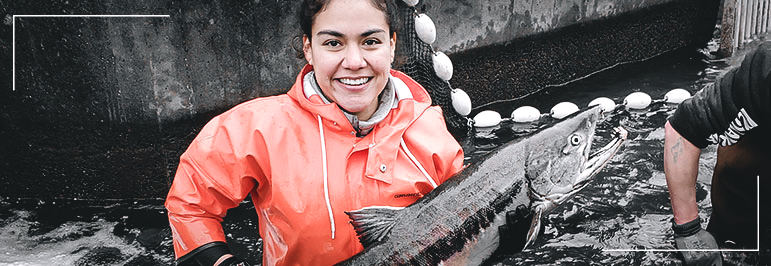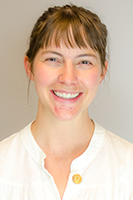Aquaculture Science

Aquaculture – Fish Specialization - AAS
Have you ever wondered how your favorite stream gets stocked with salmon? Or how your local farm-to-table restaurant can serve sustainably raised trout? Or perhaps you are interested in the emerging sector of aquaponics, where fish and plants are farmed together? If this sounds like you, then the Aquaculture- Fish Specialization AAS Degree is the right path to start your new career.
Fish can be cultured in a variety of ways for several purposes. Here in Washington State, which supports the world’s largest hatchery system, fish culturists are in high demand to support local fisheries and aquatic ecosystems. Students in this degree learn how to raise salmon and trout for stocking purposes, with a focus on releasing Chinook to help feed the starving and endangered Southern Resident Killer Whales. Students also gain experience with rearing tilapia in our program’s 1,000-gallon aquaponics system while also learning the fundamentals of aquaculture engineering and design, systems maintenance and operations, and water quality monitoring.
Students in this degree will have a combination of in-person and online courses to increase scheduling flexibility to allow for continuous live animal care and travel to field sites. Animal care training includes broodstock management, egg fertilization and incubation, feeding and nutrition, growth and health assessments, and best strategies for release and harvest operations. To further enhance the learning experience, students are provided off-site training in a variety of state and tribal hatcheries, in addition to the award winning BTC-operated Whatcom Creek Hatchery.
Ready to start your career in fish culturing? Your training experience awaits at the state’s only college fish hatchery and one of the most unique training facilities on the West Coast.
Upon completion of this AAS degree, students will also receive the Aquaculture Theory, Fundamentals of Aquatic Science, and Salmon and Trout Culturing Techniques Certificates
Employment Information
Data are provided on a program (not credential) level
71% BTC graduate placement rate1
$49,303 starting annual wage2
$56,597 average annual wage2
$66,348 potential annual wage2
Entry Information
When Can I Start?
This program starts Fall, Winter, and Spring.
What are the Minimum Entry Requirements?
A completed college admissions application and placement in English and Math. BTC uses a Guided Self-Placement process to help you choose the best starting point for your English and Math courses. Your selections will determine whether you begin with program coursework or complete prerequisites classes first.
To get started or for help determining your English and math placement, contact the Outreach department at Outreach@btc.edu
What are My Next Steps?
Classes
Total Program Credits: 100
General Education Core Courses
AMATH 111 Applied Technical Math 5 CR OR Higher AENGL 100 Applied English 5 CR OR ENGL& 101 English Composition I 5 CR OR Higher CMST& 210 Interpersonal Communication 5 CR OR CMST& 220 Public Speaking 5 CR OR PSYC& 100 General Psychology 5 CR OR SOC& 101 Introduction to Sociology 5 CR TOTAL General Education Core Course Credits 15 CR Core Courses for Program
AQUA 101 Introduction to Applied Sciences 2 CR AQUA 111 Applied Techniques: Fall 3 CR AQUA 112 Applied Techniques: Winter 1 CR AQUA 113 Applied Techniques: Spring 2 CR AQUA 121 Principles of Aquaculture 5 CR AQUA 122 Principles of Fisheries Science 5 CR AQUA 131 Aquatic Chemistry with Lab 5 CR AQUA 141 Research Methods 3 CR AQUA 271 Data Analysis for Aquatic Sciences 5 CR AQUA 272 Introduction to GIS 5 CR AQUA 273 Animal Genetics with Lab 5 CR AQUA 274 Organismal Biology with Lab 5 CR ENVS& 101 Fundamentals of Environmental Science 5 CR OCEA& 101 Introduction to Oceanography with Lab 5 CR TOTAL Core Courses for Program Credits 56 CR Program Specialty
AQUA 201 Aquaculture Internship I 6 CR AQUA 233 Fish Culture: Broodstock & Early Life 2 CR AQUA 234 Fish Culture Practicum: Winter 1 CR AQUA 235 Aquaponics 2 CR AQUA 236 Fish Culture: Nutrition & Health 2 CR AQUA 237 Fish Culture Practicum: Spring 1 CR AQUA 241 Fisheries Stock Enhancement 2 CR AQUA 242 Fisheries Stock Enhancement Practicum 3 CR AQUA 252 Aquaculture Management 5 CR AQUA 297 Aquaculture Internship II 5 CR TOTAL Program Specialty Course Credits 29 CR
Program Outcomes
After successfully completing the AAS degree, students will be able to:
- Demonstrate proper fish culturing techniques, as related to hatchery and farm production.
- Design and visualize aquaculture systems that implement industry-standard protocols and best practices.
- Describe the form and function of commonly cultured fish species, as related to reproduction, growth, and health.
- Explain current regulations, policies, and permitting in the aquaculture industry that promote sustainable production.
- Evaluate industry best practices for stock enhancement, restoration, and food production, with an emphasis on Pacific Northwest salmon and trout.
- Summarize the fundamental theories of aquatic science, as related to biology, chemistry, ecology, and environmental science.
- Produce technical communications to effectively illustrate research skills and data literacy.
- Conduct workplace operations in a safe and professional manner with an emphasis on teamwork skills.
Employment Outlook
The Fisheries & Aquaculture Sciences AAS degree prepares students for direct entry into diverse workforce opportunities. Graduates qualify for Hatchery Specialist 2 and Scientific Technician 2 positions with Washington Department of Fish and Wildlife, Biological Technician GS 4 positions with the federal government, and employment in tribal government, private, and nonprofit sectors.
The average annual wage in this field is $45,521, with an earning potential of about $57,231 per year.*
Program graduates work as fish hatchery specialists, fish culturists, fisheries technicians, shellfish hatchery workers, and scientific aides.
Faculty & Support

Brittany Palm
Fisheries & Aquaculture Sciences
Sara Smith
Fisheries & Aquaculture Sciences
Kai Rick
Hatchery Operations Specialist
Steeve Pomerleau
Fisheries & Aquaculture
Kai Rick
Hatchery Operations Specialist
